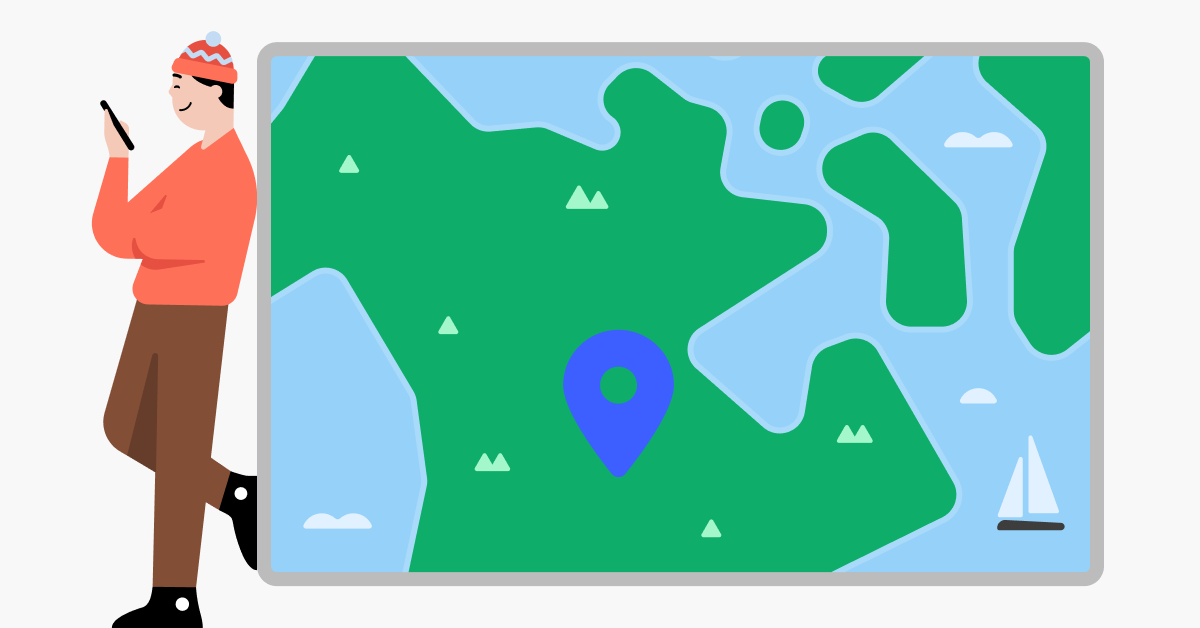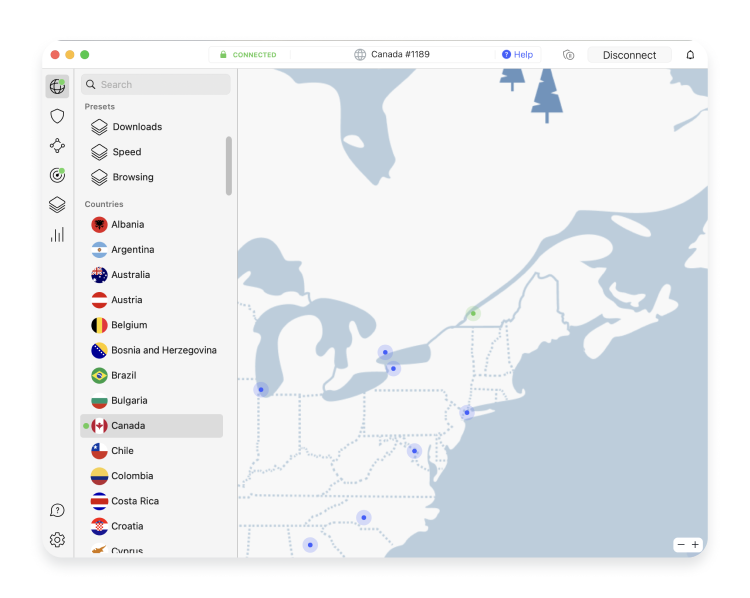How to get a Canadian IP address from anywhere
Accessing Canadian content while traveling may be challenging due to internet restrictions abroad. News websites, streaming sites, and banks sometimes restrict access from foreign IP addresses due to licensing agreements and broadcasting rights and to prevent fraud. Change your IP with a VPN, a proxy server, or the Tor browser and browse without limits.

Table of Contents
Table of Contents
What is a Canadian IP address?
A Canadian IP address is an IP address assigned to an internet server in Canada. When your device connects to the internet, it receives an IP address, ensuring the connection is smooth and the communication with the server is accurate. Connecting to a Canadian IP address indicates online services that you’re physically in Canada even when you’re outside the country.
When your IP address indicates your location abroad, you might be unable to access Canadian content. So using a Canadian IP will allow you to access home content while traveling or working from another country. Moreover, hiding your location will enhance your browsing privacy and protect your online traffic from prying eyes.
Why would you want a Canadian IP address?
Connecting to a Canadian IP address will allow you to use the internet as if you’re in Canada, even abroad. It can broaden your online experiences while traveling in restricted areas and provide a shield against cyber threats. Let’s look into the benefits that come with connecting to a Canadian server:
- Access your home content while traveling. You may be unable to access your home content when traveling abroad unless you have a Canadian IP address. Connecting to a Canadian server will allow you to access your usual Canada-based TV shows, streaming sites, and business resources without hassle.
- Online banking. Some banking websites restrict access to their services abroad to mitigate the risk of fraud and unauthorized access. To use your Canadian online banking account, you must connect to a Canadian server.
- Shopping online at lower prices. Online shops often offer different prices and discounts depending on the buyer’s location. Connecting to a Canadian server from abroad will enable you to explore price differences between your location and Canada and get the best flight deals, hotels, car rentals, and goods.
- Better privacy and security. Besides granting access to home content, changing your IP address will scramble your online traffic and protect your privacy while you are connected to a hotel or airport Wi-Fi, for example. Hackers, targeting unsuspecting users, often exploit public Wi-Fi. So masking your IP address will minimize entry points for cyberattacks and data theft.
How to get a Canadian IP address
You can change your IP address to Canada in three ways – through a virtual private network (VPN), a proxy, or the Tor browser. Some of these methods are easier to implement, while others might require some technical know-how. So it is essential to know their differences. Let’s explore which one may best suit your needs.
Use a VPN
A VPN is probably the easiest way to connect to a Canadian VPN server and get a Canadian IP address. A VPN routes your online traffic through a server in Canada and hides your actual IP. Websites and online services will see your location in Canada, allowing you to access local content that otherwise would not be available. Some high-end VPN services offer multiple server locations in the country, such as Toronto, Vancouver, and Montreal.
Apart from hiding your location, a VPN will encrypt your traffic and make it unreadable for internet service providers (ISPs) and hackers who are after your data. And if you want extra privacy, NordVPN offers a wide range of VPN features, like Double VPN servers, which route your data through two servers instead of one, Threat Protection Pro, which scans your files for malware during download, and Dark Web Monitor, which scans the dark web for your leaked data.
The best part is that connecting to a Canadian server through a VPN service is as easy as pie. If you own a NordVPN subscription, follow these steps:
- Download the VPN app and log in to your account.
- Click on “More connection options” on a card on the left.
- Choose “Canada” from the drop-down menu. A VPN will automatically connect you to a recommended server. If you want to change the server, press the three dots next to “Canada,” and a list of alternative servers in the country will appear.

One of the main drawbacks of a VPN is that a trustworthy VPN will cost you money. Even though you may find some free VPN alternatives on the market, they come packaged with many cons. Free VPNs often lack security, limit speeds, overload their software with ads, and potentially sell your sensitive data to third parties.
The pros and cons of VPNs include:
| Pros | Cons |
|---|---|
| Masks your IP address | Some VPNs log data |
| Encrypts data transfers | Poor-quality VPNs offer weak security |
| Offers fast speeds | Free VPNs reduce internet speeds |
| User-friendly software | Trusty VPNs are expensive |
| Customer support | Troubleshooting may be complex for non-techy users |
Use a proxy server
A proxy server is another tool that can hide your actual IP and connect you to a Canadian server. It acts as an intermediary between your device and the internet. Similar to a VPN, the request first routes through a proxy server to the destination, then returns to a proxy server, which returns the request to your device. Proxy servers are easy to configure. Just follow the instructions below.
- Open Google Chrome and click the three dots in the upper-right corner.
- Click on “Settings.”
- Open the “System” section.
- Click on “Open your computer’s proxy settings.” This will direct you to your computer’s proxy settings.
- For Windows, turn on “Use a proxy server” under “Manual proxy setup” and enter the proxy IP address and port number. Then click “Save.”
- For macOS, choose “Web proxy (HTTP)” and “Secure web proxy (HTTPS)” and then enter the proxy IP address and port number.
Wondering how a proxy is different from a VPN? Although using a proxy server to get a Canadian IP address is convenient, it doesn’t encrypt your online traffic. Data transfer encryption helps you avoid eavesdropping, cyberattacks, and ISP throttling. So keep this in mind when choosing a tool to get a Canadian IP.
Here’s a more comprehensive breakdown of the pros and cons of using a proxy server to get a Canadian IP address:
| Pros | Cons |
|---|---|
| Access websites and services only available in Canada | No encryption — fewer security features than a VPN service |
| Easy and quick to configure | Can reduce connection speed |
| Often cheaper than a VPN service, and some are free | Some websites block access from proxy servers |
Use a Tor browser
The Tor browser, or The Onion Router, is a free online tool for safe browsing. It works similarly to regular browsers like Chrome or Firefox, although the setup process differs slightly. A Tor browser must first establish a connection to the Tor network to operate, but the rest is pretty intuitive.
The main point of the Tor browser is to route your online traffic through multiple nodes to hide your identity and your actual IP address by assigning you another random IP address. However, if you want to connect to a VPN server in a specific location, in this case, Canada, you can do that, too. Setting up the Tor browser may require a bit more technical know-how than setting up a VPN or a proxy server. Follow this process to change your IP with the Tor browser:
- Download the Tor browser from the Tor Project website.
- Open the Tor installation folder and go to “Browser,” then click “TorBrowser.” Head to “Data,” and then click “Tor.”
- Open the “torrc” file using a text editor.
- Enter “ExitNodes (ca) StrictNodes 1” to connect to a Canadian IP address.
- Click “Save” and restart the Tor browser.
Of the three options, the Tor browser is the most complicated way to change an IP address and has the most disadvantages. Because it routes your online traffic through multiple nodes, Tor usually slows down internet speeds. In addition, because the Tor browser routes your traffic through a network of volunteer-operated exit nodes, you may never know whether the node itself isn’t set for malicious purposes.
Below, find more advantages and disadvantages of the Tor browser:
| Pros | Cons |
|---|---|
| Strong encryption | Reduced internet speed |
| Access to Onion sites | Complex setup |
| Free for all users | Can be blocked by certain entities |
Get a dedicated Canada IP address
A dedicated Canada IP address is a permanent and unchanging IP address assigned to a network. You become the only owner of that IP address. Having a dedicated IP address has advantages. For example, you can skip the identity verification process every time you connect to your regular services. Sometimes, websites block IP addresses used by more than one user, so a dedicated IP helps you avoid that, too.
Some premium VPNs, such as NordVPN, can offer you a dedicated Canadian IP. Sharing a server with other users may get you blocklisted from your favorite services due to other people’s shenanigans. You can avoid that by getting a static IP address. Moreover, it may make access to business resources much smoother and make your overall online experience more seamless.
What is the best VPN for getting a Canadian IP address?
The safest and fastest VPN for a Canadian IP is most probably NordVPN. It provides over 6400 ultra-fast servers in 111 countries, allowing you to switch between them anytime. Besides granting access to your home content while traveling, NordVPN hides your internet traffic from ISPs and hackers, creates a safe connection to public Wi-Fi, and prevents bandwidth throttling.
NordVPN also has advanced security features to protect your data everywhere you browse. Threat Protection Pro scans your files for malware while they are downloading, Dark Web Monitor checks the dark web for your leaked data, and Meshnet establishes a secure tunnel for remote access.
